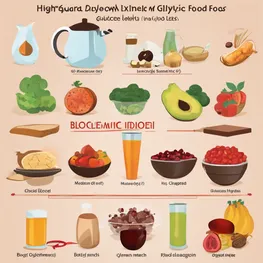Table of contents
- The art of choosing the best restaurant for your meal
- Chart Your Course in Advance
- Harnessing Curiosity: The Key to Asking Questions
- Mastering Portion Control
- Health risks of drinking sugary drinks
- Uncover the Hidden Dangers of Sauces and Dressings
- Smart Dessert Choices for a Healthy Lifestyle
Maintaining stable blood sugar levels while dining out can be challenging, especially for individuals with diabetes. However, with the right strategies and expert advice, it is possible to enjoy meals at restaurants without experiencing drastic spikes in blood sugar. In this article, we will provide valuable tips and insights from experts on how to navigate restaurant menus, make healthier choices, and keep blood sugar levels in check while indulging in delicious food.
The art of choosing the best restaurant for your meal
When it comes to choosing the best restaurant for your meal, it's important to consider the health factor. By doing a bit of research and selecting restaurants that offer healthy, low-sugar options, you can enjoy a delicious meal without compromising your well-being. Here are some points to keep in mind:
- Check the menu: Before visiting a restaurant, take a look at their online menu. Look for items labeled as healthy, low-sugar, or light options. This will give you an idea of the restaurant's commitment to offering healthier choices.
- Ask for modifications: If you don't find many healthy options on the menu, don't hesitate to ask the staff if they can make modifications to existing dishes. Many restaurants are willing to accommodate dietary requests.
- Look for whole food ingredients: A good indicator of a healthy restaurant is the use of whole food ingredients. Look for dishes that incorporate fresh fruits, vegetables, lean proteins, and whole grains.
- Consider portion sizes: Another aspect of a healthy meal is portion control. Look for restaurants that offer smaller portion sizes or allow you to customize your portion.
- Read reviews and ratings: In addition to looking at the menu, read reviews and ratings of restaurants. This can give you an insight into other customers' experiences with healthy, low-sugar options.
- Consider the ambiance: Finally, consider the ambiance of the restaurant. Opt for a place that promotes a relaxed and comfortable dining experience, as it can contribute to a healthier mindset while enjoying your meal.
Chart Your Course in Advance
When planning your dining experience, it is important to check the restaurant's menu in advance. By doing so, you can identify suitable dishes that meet your dietary preferences or restrictions. This will ensure that you have an enjoyable meal without any unwanted surprises. Take the time to review the menu online or call the restaurant directly to inquire about specific ingredients or options. By charting your course in advance, you can make informed choices and have a more satisfying dining experience.
Harnessing Curiosity: The Key to Asking Questions
When dining out, it's important to embrace your curiosity and ask your server about ingredients, preparation methods, and possible substitutions. This empowers you to make informed choices that align with your dietary restrictions and preferences.
Mastering Portion Control
One effective strategy for mastering portion control is to share meals or ask for half to be packed in a to-go container.
-
Benefits of Sharing Meals
By sharing meals with someone, you can significantly reduce your portion sizes. Sharing not only helps you control your calorie intake, but it also encourages social interaction and fosters a sense of connection.
-
Utilizing To-Go Containers
Another way to control portion sizes is by asking for half of your meal to be packed in a to-go container. This allows you to enjoy a satisfying portion at the restaurant and save the remaining portion for later. It helps prevent overeating and promotes mindful eating by spreading out your calorie intake throughout the day.
-
Practical Tips for Implementing this Strategy
To successfully share meals or utilize to-go containers, communicate your preferences with your dining partner or server. Discuss portion sizes and consider ordering appetizers or sides instead of full meals. Additionally, make sure to choose healthier options and avoid high-calorie dishes to maintain a balanced diet.
-
The Importance of Portion Control
Mastering portion control is vital for weight management and overall health. It helps prevent excessive calorie consumption, aids in weight loss or maintenance, and reduces the risk of associated health complications, such as obesity and diabetes.
Health risks of drinking sugary drinks
When it comes to quenching our thirst, we often reach for sugary drinks without considering the health risks associated with them. However, making a simple switch to healthier options can have a significant impact on our overall well-being. Instead of indulging in sugary drinks, it is advisable to choose water, unsweetened tea, or diet sodas. Here are a few reasons why:
-
Reduced calorie intake
Sugary drinks, such as soda and sweetened juices, are loaded with empty calories. By opting for water, unsweetened tea, or diet sodas, you can significantly reduce your calorie intake, making it easier to maintain a healthy weight.
-
Improved hydration
Water is the best thirst quencher, providing essential hydration without any added sugars. Unsweetened tea and diet sodas, though not as hydrating as water, can be suitable alternatives for those seeking variety.
-
Reduced risk of chronic diseases
Drinking sugary beverages regularly increases the risk of developing chronic conditions such as obesity, type 2 diabetes, heart disease, and certain types of cancer. By opting for healthier alternatives, you can significantly lower your risk of these diseases.
-
Better dental health
Sugary drinks can wreak havoc on our teeth, leading to tooth decay and cavities. Choosing water, unsweetened tea, or diet sodas can help prevent dental problems and maintain a healthy smile.
Uncover the Hidden Dangers of Sauces and Dressings
Discover the secrets to unleashing the full potential of your meal while maintaining control over your health and taste buds. Request dressings on the side to enjoy the perfect balance of flavor without compromising your well-being. Here's why you should embrace this simple yet powerful strategy:
-
Control Over Portion Size
By requesting dressings on the side, you have complete control over the amount you add to your dish. This allows you to prevent excessive dressing from overpowering the flavors of the other ingredients and ensures that you're not consuming excessive calories, fats, or sugars.
-
Healthier Choices
Many restaurant dressings and sauces are packed with unhealthy ingredients like high-fructose corn syrup, preservatives, and artificial additives. By having dressings on the side, you have the opportunity to choose healthier alternatives or use them sparingly, promoting a more nourishing and balanced meal.
-
Taste Customization
Having dressings on the side provides you with the freedom to customize the taste of your meal according to your preferences. You can mix a small amount of dressing with the dish to enhance the flavors without overpowering them or even choose to dip each bite for a burst of flavor whenever desired.
-
Allergy and Sensitivity Considerations
If you have any allergies or dietary restrictions, requesting dressings on the side allows you to avoid potential allergens or ingredients that may cause adverse reactions. It empowers you to enjoy your meal without compromising your health or experiencing any discomfort.
Smart Dessert Choices for a Healthy Lifestyle
Making smart dessert choices is essential for maintaining a healthy lifestyle. Opting for desserts with low sugar content can help you satisfy your sweet tooth without sacrificing your health. Instead of indulging in sugary treats, consider including fresh fruit or sugar-free options in your diet. Here are a few reasons why you should choose desserts with low sugar content:
- Reduced risk of chronic diseases: Consuming excessive amounts of sugar is linked to an increased risk of chronic conditions like obesity, diabetes, and heart disease. By choosing desserts with low sugar content, you can minimize these risks and better protect your long-term health.
- Improved weight management: High-sugar desserts are often calorie-dense and can contribute to weight gain. Opting for low-sugar alternatives like fresh fruit allows you to enjoy a satisfying dessert while keeping your calorie intake under control. This can support your efforts to maintain or achieve a healthy weight.
- Enhanced energy levels: Sugar-filled desserts can cause energy crashes and leave you feeling lethargic. By choosing low-sugar options, you can avoid the highs and lows associated with sugar consumption, helping you maintain stable energy levels throughout the day.
- Better dental health: Excessive sugar consumption can lead to tooth decay and other dental problems. Choosing desserts with low sugar content, such as sugar-free options, can help protect your teeth and promote better oral health.
- Support for a balanced diet: Eating desserts with low sugar content allows you to satisfy your sweet cravings while still following a balanced diet. By incorporating nutrient-rich fruits or sugar-free treats into your dessert choices, you can enjoy a guilt-free indulgence that contributes positively to your overall nutrition.
In conclusion, managing blood sugar levels while dining out is achievable with a few expert tips. By planning ahead, selecting appropriate restaurants with healthier menu options, and making mindful choices during the meal, individuals can enjoy dining out without experiencing a spike in blood sugar. Communication with restaurant staff, focusing on portion control, opting for lean proteins and vegetables, and being mindful of sauces and dressings can make a significant difference in maintaining stable blood sugar levels. With a little knowledge and preparation, dining out can still be a pleasurable experience for individuals with diabetes or those looking to regulate their blood sugar levels.
Frequently asked questions related to diabetes friendly dining out
What are some tips for ordering at a restaurant when trying to manage blood sugar?
Some tips for ordering at a restaurant when trying to manage blood sugar include choosing foods that are low in carbohydrates, avoiding fried and breaded options, opting for grilled or steamed dishes, requesting dressings and sauces on the side, and limiting portion sizes.
How can I control my blood sugar levels while dining out?
To control blood sugar levels while dining out, you can monitor your portion sizes, choose foods with lower glycemic index, avoid sugary beverages, opt for water or unsweetened drinks, limit alcohol consumption, and stay physically active throughout the day.
Are there any specific cuisines or types of restaurants that are better for managing blood sugar?
When managing blood sugar, it is generally recommended to choose restaurants that offer healthier options such as seafood or Mediterranean cuisines. These types of cuisines often include dishes with lean proteins, vegetables, and healthy fats.
Is it possible to enjoy desserts while dining out without spiking blood sugar?
Yes, it is possible to enjoy desserts while dining out without spiking blood sugar. Some tips include opting for desserts with lower sugar content, sharing a dessert with others, choosing fruit-based desserts, or having a small portion of your favorite dessert and balancing it with healthier choices throughout the meal.
What should I do if I have limited control over the menu options at a social gathering or event?
If you have limited control over the menu options at a social gathering or event, try to focus on portion control, avoid high-carb and sugary foods, prioritize protein and fiber-rich options, and eat mindfully. You can also consider eating a small snack before the event to help manage your blood sugar levels.
Should I inform the restaurant staff about my dietary restrictions and blood sugar management needs?
It is beneficial to inform the restaurant staff about your dietary restrictions and blood sugar management needs. They may be able to provide you with more information about the ingredients and preparation methods used in the dishes, and accommodate your specific requirements.







